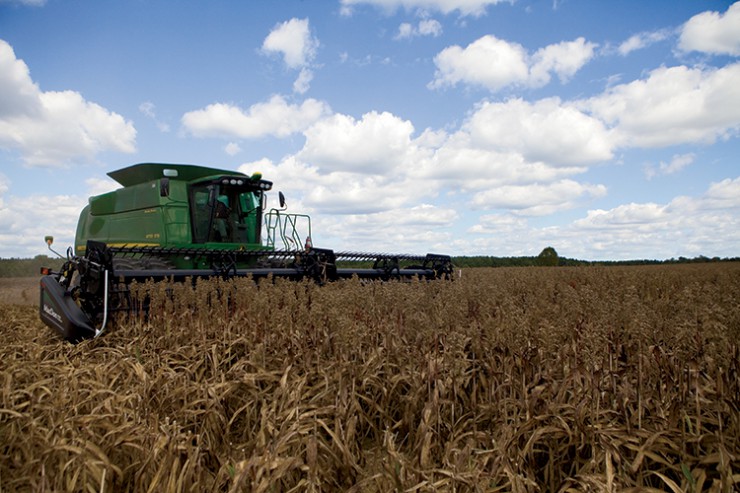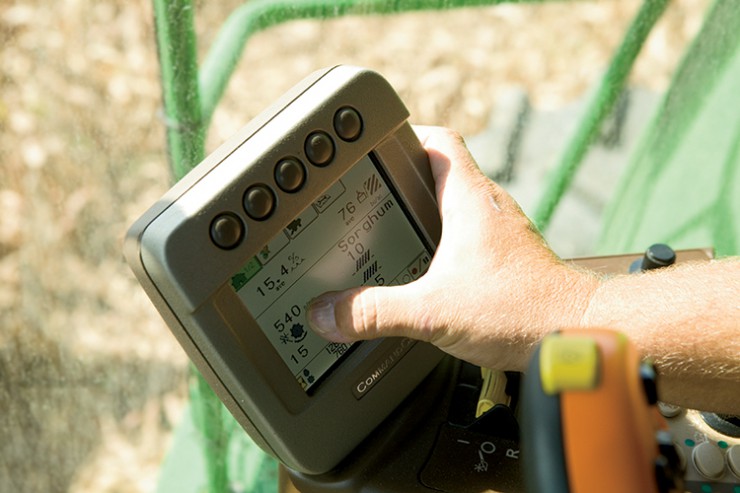Home > Virginia > Virginia Technology > Precision Agriculture in Virginia
Precision Agriculture in Virginia
In partnership with: Virginia Department of Agriculture and Consumer Services
As Keith Dunn and his father, Mac, rode in a GPS-controlled combine they talked about the changes they have seen in agriculture over the past two decades.
“It’s almost incomprehensible,” says Dunn, owner of Oak Hill Farms near Yale. “Five years ago there was no auto-steer, and now we can drive the tractor within a half-inch accuracy. We can apply fertilizer with greater precision. We can do grid sampling and zone sampling of the soil and add the exact amount of the right type of nutrients on each acre of land for the crop we plan to raise. We are more efficient than ever.”
These days the Dunns use a high-tech planter to put those crops in the ground on their 1,500 acre farm. They plant seeds at record speeds and with record precision. A GPS device inside the tractor means the rows are straight and prevents seeds from being planted in sections of the field twice as the machine makes its turns – saving both time and money.
William “Sparky” Crossman at Laurel Springs Farm in Mount Holly also praises the accuracy of the state-of-the-art agriculture equipment.
“At $275 for a 50-pound bag of corn for planting, it’s important we don’t plant the same area twice,” Crossman says. “The accuracy of today’s technology makes sure that doesn’t happen.”
The technology also helps ensure every acre is producing at maximum capacity, he says.
“GPS mapping helps us identify where we aren’t getting the yield we expect,” Crossman says. “Then we can use a handheld GPS to go to those spots and find out whether the problem is the soil type, the pH or something else. We can address the problem and increase the yield.”
Laurel Springs and Oak Hill Farms grow corn, soybeans and wheat – three of Virginia’s top four crops. The latest figures for Virginia put cash receipts at $212 million for corn, $302 million for soybeans and $109 million for wheat. Oak Hill also grows cotton, which generated $69 million in cash receipts for Virginia in 2012.
Both Laurel Springs and Oak Hill use crop sprayers with the same precision technology as the planters.
“We can program the sprayer for the height we want, say 25 inches above the soybeans, and it will be accurate from tip to tip of the boom with a 100-foot swath,” Dunn says. “The computer and sensors on the boom won’t let the sprayer overlap. If the boom swings over an area already sprayed, the computer will shut that section of the sprayer down. That saves money and provides better care for the crops.”
Crossman says the technology available has made plowing the fields a thing of the past. “We do what’s known as vertical tillage,” he says.
“We use a tool that goes through the field and slices the corn stalk and chops it up, creating a mulch and preventing erosion.” The same process happens with the wheat and soybeans, and then it all begins again with corn – each time enriching the soil. That method saves trips across the field, fuel and fertilizer, and the result is a richer soil that holds moisture.
A fifth-generation farmer, Crossman says the technology he incorporates today is very different from that used by his ancestors. “The idealistic picture of a farmer used to be a guy in bib overalls and a straw hat,” he says. “Farmers are using computers and satellites to grow and manage crops, and while the technology can be expensive initially, it brings an efficiency to the farm that makes it worth it.”
Dunn agrees. “We’re raising more food with less waste and more protection to the environment,” he says. “That’s good for farmers, for the land and for the consumers.”
Dunn is a seventh-generation farmer working the same land worked by his family since the late 1600s. He embraces both history and the future. He uses social media to promote agriculture in an effort to better connect his friends, family and community about how and where food is grown. He also uses his social connections to share information with other farmers.







thank you farmflavor for giving me wonderful information
Arugula is a great source of fiber, this is a great guide about preparing arugula. Nice content, good read and informative.